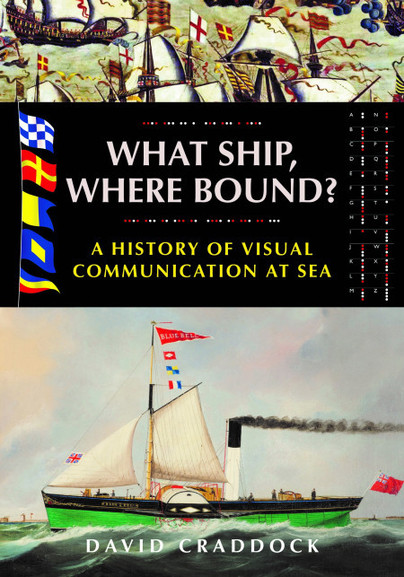
What Ship, Where Bound? A History of Visual Signalling at Sea. By David Craddock. Seaforth Publishing, Barnsley, 2021. ISBN 978-1-5267-8482-7
Reviewed by David Hobbs
This inexpensive little book is beautifully illustrated in colour to introduce readers to the evolving methods used by ships to communicate with each other visually.
The author is well qualified to explain this subject having begun his working life as a cadet with P & O before becoming a graphic designer in the museum and heritage sector. He is now a trustee of the Britannia Museum at the Royal Naval College Dartmouth.
There are three sections which cover flag signalling, semaphore and signalling with lights. Each begins with a time line which traces the history of the discipline from its earliest days to the present. The section on flags is the largest and apart from describing how their use developed, Craddock compares British and American systems as well as flags used by the Merchant Navy and in yacht racing. Several short anecdotes illustrate the important role flag signals have played in history. These include the evolution of the International Code of Signals from the code originally introduced by the British Board of Trade in 1857 and Nelson’s signal at Trafalgar. Several pages are devoted to the success and failure of visual signals during the daylight phase of the Battle of Jutland. However, I found the most interesting naval signals were those in the semaphore section on pages 71 to 73 which described exchanges made during Jutland. Although these made up only 6% of the signal traffic on the day, they are not constrained by the stilted phrases of code books and give the reader a clear idea of what the originators were thinking at the instant of their transmission. Other anecdotes abound throughout the book’s 97 pages. Did you know, for instance, that Samuel F B Morse was a portrait painter who designed the code which still bears his name to be sent by his American Electro-Magnetic Telegraph in 1838? His reason for doing so was the untimely death of his first wife while he was working on a commission away from home; news of it did not reach him until after she had been buried and that drove him to design a faster method of communication. A chart, one of many throughout the book, shows how his code has undergone three iterations before reaching the final version, that we all know today, in 1865.
The book’s title is derived from the exchanges between ships who encounter each other at sea. Hardly necessary in the digital age, these were once spoken by flag hoists or flashing light, often enlivening a dull watch or long sea transit. The author brings to life the methods used by admirals to manoeuvre their squadrons and fleets in the manner laid down in various code books as well as the methods used to send long range messages to deployed fleets. The timelines alone give fascinating insight into the history of naval communications and the publisher’s comments on the back cover claim that this book ‘will both enlighten and entertain’. I think that statement exactly describes What Ship, Where Bound? It is a delightfully written and illustrated book that will appeal to a wide readership including naval professionals, historians, yachtsmen, modellers and artists. I thoroughly recommend it.



